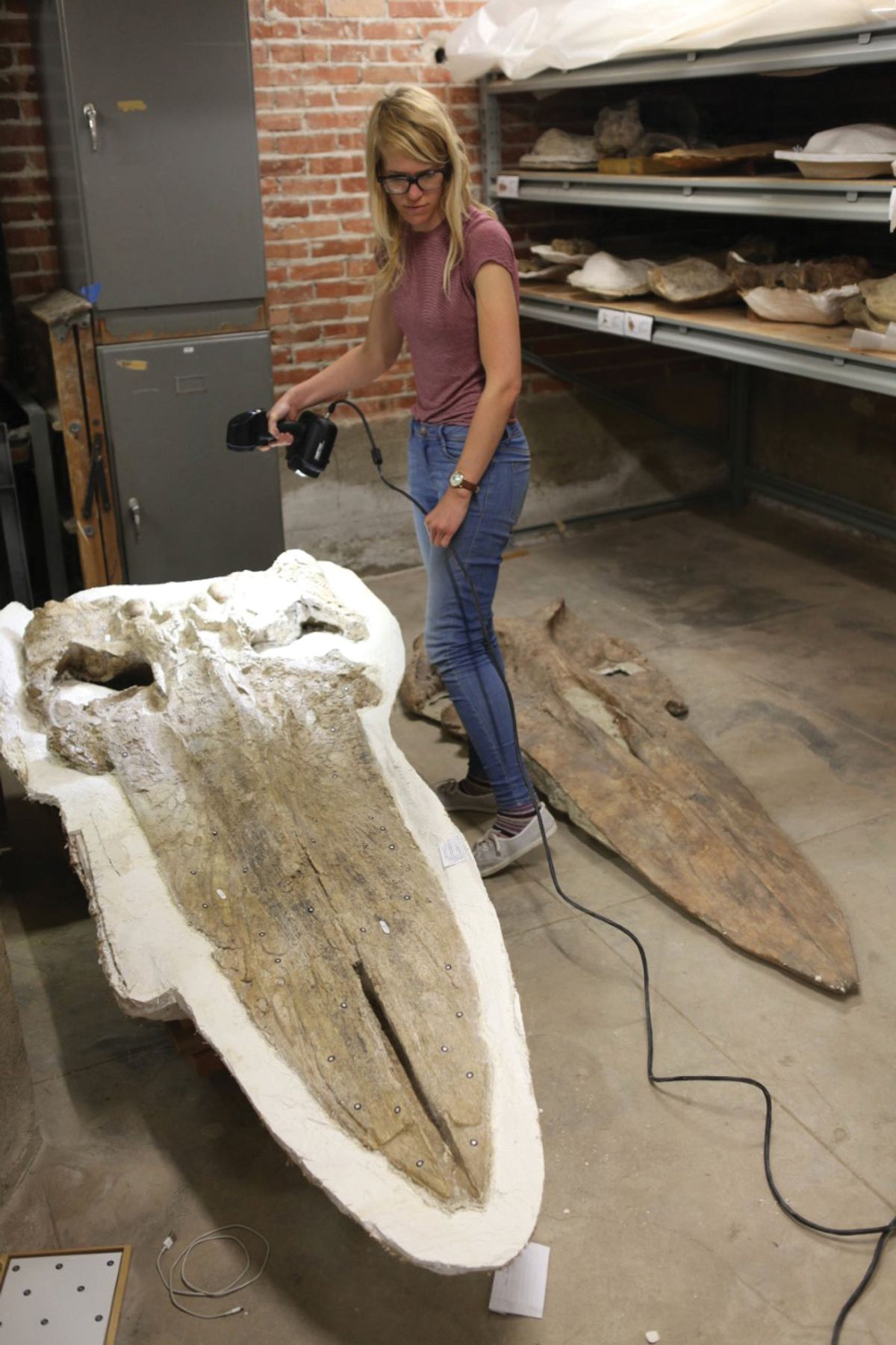ABOVE: A blue whale (Balaenoptera musculus) © ISTOCK.COM, eco2drew
Whales are weird. The Cetacea clade contains the largest animal to ever live—the blue whale—as well as other gigantic baleen whales and a diverse array of toothed whales, including dolphins, porpoises, narwhals, sperm whales, and more. The group contains some of the only fully aquatic mammals that give birth to live young in saltwater. Whales’ nostrils are on the tops of their heads. The list of bizarre characteristics goes on.
Whales’ skulls are one of their crowning oddities. Skulls in general are a paleontological treasure trove, explains paleontologist and macroevolutionary ecologist Ellen Coombs, a postdoc at the National Museum of Natural History. They host the brain, the sensory organs, and the teeth, all of which can tell researchers about the animals’ behavior and diet. For several years now, Coombs has been studying whale skull peculiarities—such as the structure’s unusual asymmetry in some species—and their implications for cetacean evolution.
She first started collecting 3D scans of whale skulls in 2018, when she was a PhD student at the Natural History Museum in London. She aimed to collate data on skulls that came from not only different periods across whales’ evolutionary history, but also various geographies, from Europe and North America to Peru and New Zealand. The basic procedure was straightforward. Using a 3D scanner, she’d take several images, then process them, clean them up, and merge them into a single, coherent 3D model.
Whales’ cranial evolution came in three waves.
That’s easier said than done when you’re scanning hundreds of skulls, especially when they’re from whales. The skull of a vaquita (Phocoena sinus), the world’s smallest cetacean, is pretty manageable, as it’s around the size of a melon. But the skull of a blue whale (Balaenoptera musculus) is more on the scale of a family sedan. Scanning a single skull could take Coombs anywhere from 30 minutes to an entire day.
Once she’d assembled the images, Coombs could place digital markers on them to note the position of particular structures. For each of the 200 or so skulls she studied, she placed more than 2,000 markers, for more than 400,000 markers in total. “It took me the good part of a year to finish,” she says. Coombs adds that she also listened to a lot of podcasts during that time.
Some findings jumped out right away, she notes. For example, the odontocetes, or toothed whales, “have very asymmetrical skulls.” In 2020, Coombs coauthored a paper on some of her initial findings, which revealed that skulls of the toothed whales had evolved to accommodate the melon, a mass of fatty tissue that amplifies the high-pitched calls that these whales produce for echolocation.

Looking deeper by mapping the skull markers onto the cetacean phylogenetic tree, she and a team of fellow whale experts and evolutionary modelers could infer when particular changes in structure had taken place—and how quickly. The findings, published this year, show that whales’ cranial evolution came in three waves. The first was right at the beginning of whale evolution, just shy of 50 million years ago, when the archaeocetes—the ancestors of modern cetaceans, which emerged in the Eocene Epoch—were first entering the water. “Within eight to twelve million years,” she says, “they went from being fully terrestrial to fully aquatic.”
The next major shift came roughly 39 million years ago when the two suborders of whales—the mysticetes (baleen whales) and the odontocetes—went their separate ways. The baleen whales began developing the long keratin sheets that enable filter feeding. That carried on until about 23 million years ago, when their rate of skull evolution slowed to a crawl. The toothed whales, meanwhile, developed echolocation, which enabled them to hunt in low-light conditions and in difficult terrain, such as murky rivers clogged with rocks or ice.
In the final wave of evolution, from roughly 18 million to 10 million years ago, there was an explosion in diversity among the toothed whales. Echolocation, unlike baleen, was a tool that could help the animals exploit many different niches, Coombs explains, thereby encouraging new adaptations and creating new species, from the river dolphins to the deep-diving sperm whales.

Anatomical scientist Paul Manger of the University of the Witwatersrand, Johannesburg, who was not involved in the work, says that one of the study’s most interesting findings is that these three occurrences of rapid changes in the anatomy of the skull “correlate with changes in brain [size during] evolution.” He notes, for example, the there was a significant increase in brain size right at the origin of odontocetes, and again around 15 million years ago at the emergence of Delphinoidea, the largest group of toothed whales and the taxon containing dolphins. “So this study does support and extend previous studies and does so very nicely,” Manger says.
Abdullah Gohar, a cetacean paleobiologist at Mansoura University in Egypt who was also not involved in the research, writes in an email that the paper was “a fabulous work. It’s fantastic to see this monumental effort come to fruition!” He says that the extreme specialization of cetacean skulls makes them an excellent target for study, as they “capture many of the extreme shifts in feeding, respiration, and sensation.”

The sheer scale of the database is worth noting too, he says. “Large databases take a long time to compile, but they allow scientists to throw light on larger trends rather than making qualitative findings based on a single fossil.” He adds that he hopes future studies “incorporate these findings to better understand cetacean evolution.”
Coombs says that she’s already had several researchers, including other evolutionary biologists, climate scientists, and behavioral ecologists, asking to use the dataset for further research, and adds that she’s not finished with it either. “There’s so many questions we can ask using this dataset alone, but there’s more we can add to it too. I’m super proud.”
Membership Open House!
Enjoy OPEN access to Premium Content for a limited timeInterested in exclusive access to more premium content?




